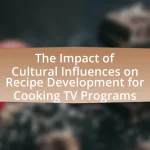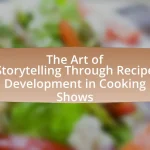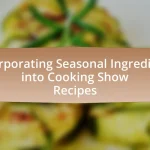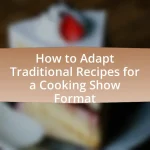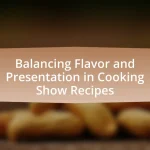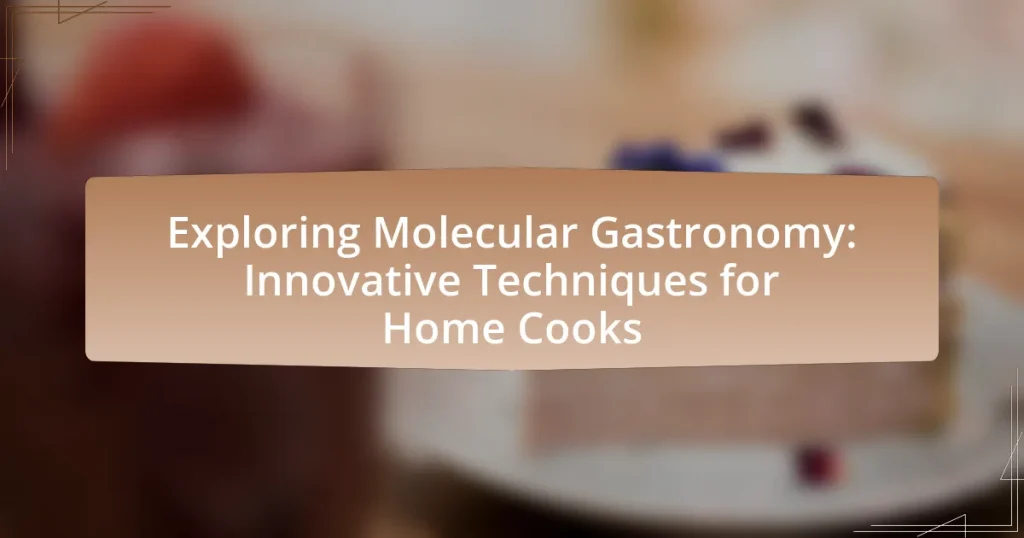Molecular gastronomy is a specialized branch of food science that examines the physical and chemical changes that occur during cooking, utilizing scientific techniques to enhance culinary experiences. This article explores the origins of molecular gastronomy, highlighting key figures such as Hervé This and Nicholas Kurti, and discusses fundamental principles, innovative techniques, and essential tools for home cooks. It also addresses common challenges and mistakes faced by amateur chefs, providing practical tips for successful experimentation with molecular gastronomy methods like spherification, emulsification, and sous-vide cooking. Through this exploration, readers will gain insights into how to implement these advanced culinary techniques in their own kitchens.
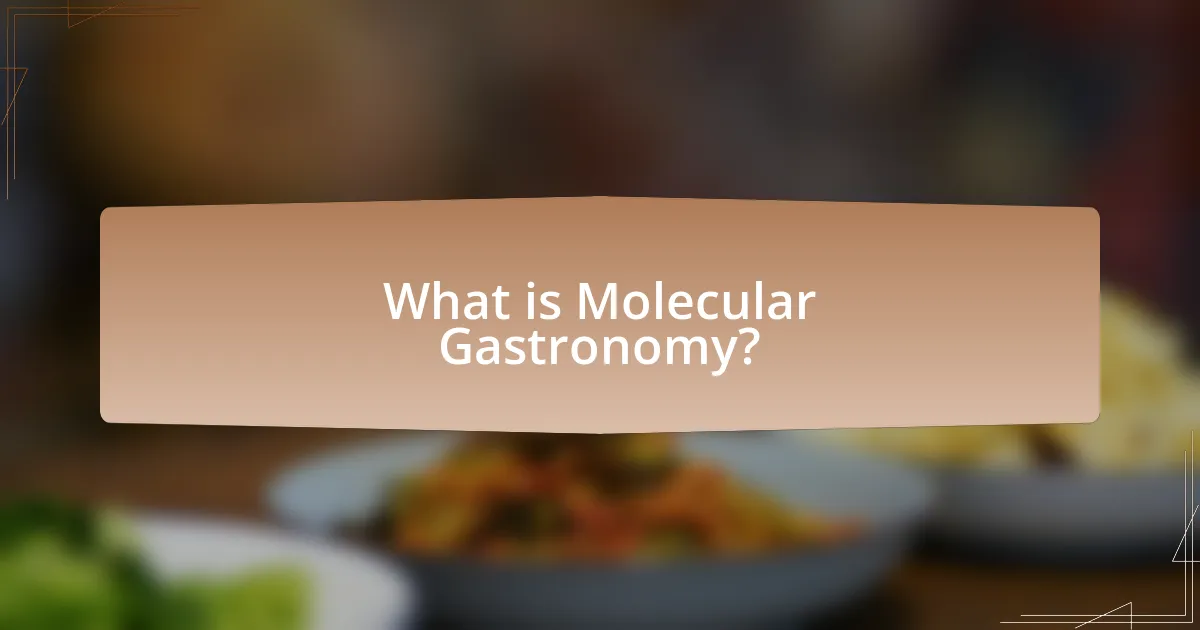
What is Molecular Gastronomy?
Molecular gastronomy is a sub-discipline of food science that focuses on the physical and chemical transformations of ingredients during cooking. This culinary approach employs scientific techniques and tools, such as sous-vide cooking, spherification, and emulsification, to create innovative textures and flavors in dishes. The term was popularized in the late 20th century by chefs like Ferran Adrià and Heston Blumenthal, who utilized scientific principles to enhance the dining experience.
How did Molecular Gastronomy originate?
Molecular gastronomy originated in the late 20th century as a scientific approach to cooking, primarily popularized by chefs such as Ferran Adrià and Heston Blumenthal. This culinary movement emerged from the collaboration between chefs and scientists, aiming to explore the physical and chemical transformations of ingredients during cooking. The term “molecular gastronomy” was coined by physicist Nicholas Kurti and chemist Hervé This in the 1980s, who sought to understand the science behind culinary techniques. Their research laid the groundwork for innovative cooking methods that utilize modern technology, such as spherification and emulsification, which have since become staples in contemporary cuisine.
Who are the key figures in the development of Molecular Gastronomy?
The key figures in the development of Molecular Gastronomy are Hervé This and Nicholas Kurti. Hervé This, a French chemist, is credited with coining the term “Molecular Gastronomy” in the late 1980s and has conducted extensive research on the science of cooking. Nicholas Kurti, a physicist, collaborated with This and contributed to the foundational principles of the discipline, emphasizing the scientific understanding of culinary processes. Their combined efforts have significantly shaped the field, leading to a greater appreciation of the chemistry involved in cooking.
What historical events influenced the rise of Molecular Gastronomy?
The rise of Molecular Gastronomy was influenced by several key historical events, including the development of scientific techniques in the late 20th century that allowed chefs to explore the chemical and physical transformations of food. The publication of “Molecular Gastronomy: Exploring the Science of Flavor” by Hervé This and Nicholas Kurti in 1988 marked a significant moment, as it introduced scientific principles to culinary practices. Additionally, the increasing popularity of avant-garde cuisine in the 1990s, exemplified by chefs like Ferran Adrià and Heston Blumenthal, further propelled the movement, showcasing innovative techniques such as spherification and foaming. These events collectively contributed to the establishment of Molecular Gastronomy as a recognized culinary discipline.
What are the fundamental principles of Molecular Gastronomy?
The fundamental principles of Molecular Gastronomy include the scientific understanding of cooking processes, the transformation of ingredients through physical and chemical changes, and the use of innovative techniques to enhance flavors and textures. These principles are grounded in the application of scientific methods to culinary practices, allowing chefs to manipulate food at a molecular level. For example, techniques such as spherification, emulsification, and gelification illustrate how molecular gastronomy alters the physical properties of food, creating new sensory experiences. The work of scientists like Hervé This and Nicholas Kurti has established a framework for these principles, emphasizing the importance of experimentation and precision in cooking.
How do science and cooking intersect in Molecular Gastronomy?
Science and cooking intersect in Molecular Gastronomy through the application of scientific principles to culinary techniques, enhancing flavor, texture, and presentation. This field utilizes methods such as spherification, emulsification, and sous-vide cooking, which rely on chemical reactions and physical transformations to create innovative dishes. For example, spherification involves the use of sodium alginate and calcium chloride to form gel-like spheres that burst with flavor, demonstrating how understanding molecular interactions can lead to new culinary experiences.
What role do chemical reactions play in cooking techniques?
Chemical reactions are fundamental to cooking techniques as they transform ingredients, affecting flavor, texture, and appearance. For instance, the Maillard reaction, which occurs when proteins and sugars are heated, creates complex flavors and browning in foods like roasted meats and baked bread. Additionally, emulsification, a chemical process where fats and liquids combine, is crucial in making sauces like mayonnaise. These reactions not only enhance the sensory qualities of food but also contribute to food safety by killing harmful bacteria during cooking.
What are the essential tools and ingredients used in Molecular Gastronomy?
The essential tools used in Molecular Gastronomy include a sous-vide machine, a siphon, and a blowtorch, while key ingredients consist of agar-agar, sodium alginate, and calcium chloride. The sous-vide machine allows precise temperature control for cooking, ensuring consistent results. A siphon is used for creating foams and emulsions, enhancing texture and presentation. The blowtorch is employed for techniques like caramelization and finishing dishes. Agar-agar serves as a gelling agent derived from seaweed, while sodium alginate and calcium chloride are used in spherification, a technique that creates caviar-like spheres. These tools and ingredients are foundational for executing innovative culinary techniques in Molecular Gastronomy.
Which tools are necessary for home cooks to start experimenting?
Home cooks need a few essential tools to start experimenting with molecular gastronomy, including a sous-vide machine, a kitchen scale, and a siphon. A sous-vide machine allows for precise temperature control, which is crucial for achieving desired textures and flavors in food. A kitchen scale ensures accurate measurements of ingredients, which is vital for chemical reactions in molecular gastronomy. A siphon is used for creating foams and emulsions, adding innovative textures to dishes. These tools enable home cooks to explore and apply the techniques of molecular gastronomy effectively.
What unique ingredients are commonly used in Molecular Gastronomy?
Unique ingredients commonly used in Molecular Gastronomy include sodium alginate, calcium chloride, and agar-agar. Sodium alginate, derived from brown seaweed, is used for spherification, allowing chefs to create liquid-filled spheres. Calcium chloride acts as a setting agent in conjunction with sodium alginate, facilitating the formation of these spheres. Agar-agar, a gelatin substitute made from red algae, is utilized for gelling and thickening, providing a vegan alternative to traditional gelatin. These ingredients enable innovative culinary techniques that transform textures and presentations in modern cooking.
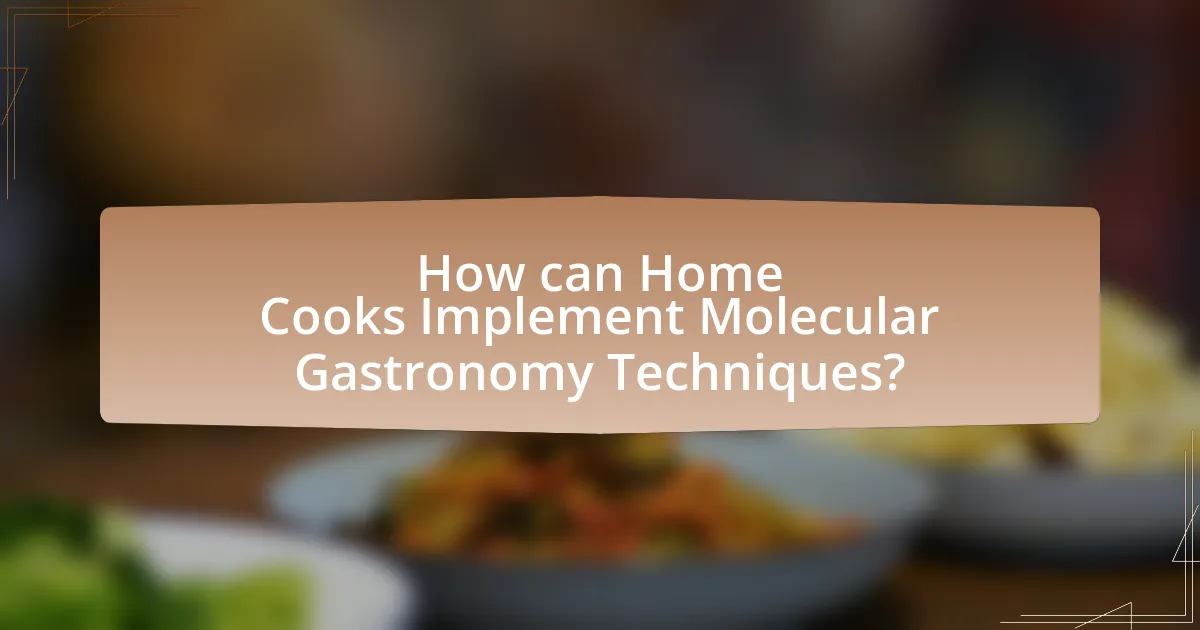
How can Home Cooks Implement Molecular Gastronomy Techniques?
Home cooks can implement molecular gastronomy techniques by utilizing specific tools and ingredients that facilitate the transformation of textures and flavors in food. For instance, they can use spherification kits to create caviar-like spheres from liquids, employing sodium alginate and calcium chloride to achieve this effect. Additionally, home cooks can experiment with foaming agents like lecithin to create airy foams that enhance the presentation and taste of dishes. The use of sous-vide cooking methods allows for precise temperature control, resulting in perfectly cooked proteins while retaining moisture and flavor. These techniques are supported by the growing availability of molecular gastronomy kits and resources, making it feasible for home cooks to explore this innovative culinary art.
What innovative techniques can home cooks try?
Home cooks can try techniques such as spherification, emulsification, and sous-vide cooking to explore molecular gastronomy. Spherification involves creating liquid-filled spheres that burst in the mouth, achieved by combining sodium alginate with calcium chloride. Emulsification allows for the creation of stable mixtures of oil and water, often used in making foams or sauces, utilizing ingredients like lecithin. Sous-vide cooking involves vacuum-sealing food and cooking it at precise temperatures in a water bath, ensuring even cooking and enhanced flavors. These techniques have been popularized by chefs like Ferran Adrià and Heston Blumenthal, demonstrating their effectiveness in elevating home cooking.
How can spherification be achieved at home?
Spherification can be achieved at home by using sodium alginate and calcium chloride. To perform spherification, mix a liquid containing flavoring with sodium alginate, then drop this mixture into a calcium chloride solution. The sodium alginate reacts with calcium ions, forming a gel-like membrane around the liquid, creating spheres. This technique is widely used in molecular gastronomy and allows for the encapsulation of flavors, resulting in a unique culinary experience.
What is the process of emulsification in Molecular Gastronomy?
Emulsification in Molecular Gastronomy is the process of combining two immiscible liquids, such as oil and water, into a stable mixture. This is achieved by using emulsifiers, which are substances that reduce the surface tension between the liquids, allowing them to blend. Common emulsifiers include lecithin, found in egg yolks, and mono- and diglycerides. The technique often involves mechanical action, such as whisking or blending, to create a uniform emulsion, which can be used in various culinary applications like sauces and dressings. The stability of the emulsion can be enhanced by controlling factors such as temperature and the ratio of ingredients, ensuring a consistent texture and flavor in the final dish.
What are some beginner-friendly recipes using Molecular Gastronomy?
Beginner-friendly recipes using Molecular Gastronomy include spherification, foaming, and gelification. Spherification involves creating caviar-like spheres using sodium alginate and calcium chloride, which can be made with fruit juices or flavored liquids. Foaming can be achieved by using a whipping siphon to create light, airy foams from purees or broths, enhancing flavors in a dish. Gelification allows for the transformation of liquids into gels using agar-agar or gelatin, which can be used to create unique textures in desserts or savory dishes. These techniques are accessible and can be easily practiced at home, making them ideal for novice cooks interested in Molecular Gastronomy.
How can home cooks create a simple foam or espuma?
Home cooks can create a simple foam or espuma by using a combination of liquid, a stabilizing agent, and an aeration method. To achieve this, they can blend a flavored liquid, such as fruit juice or broth, with a stabilizer like lecithin or gelatin, and then use an immersion blender or a whipped cream dispenser to incorporate air, resulting in a light, airy foam. This technique is supported by the principles of molecular gastronomy, which emphasize the transformation of ingredients through physical and chemical processes to enhance texture and flavor.
What are some easy spherification recipes for beginners?
Some easy spherification recipes for beginners include fruit juice caviar, yogurt pearls, and balsamic vinegar spheres. For fruit juice caviar, mix fruit juice with sodium alginate, then drop it into a calcium chloride bath to form spheres. Yogurt pearls can be made by blending yogurt with a small amount of sodium alginate and then using the same calcium bath technique. Balsamic vinegar spheres require mixing balsamic vinegar with sodium alginate and dropping it into a calcium solution as well. These recipes utilize basic spherification techniques that are accessible and require minimal ingredients, making them ideal for beginners in molecular gastronomy.
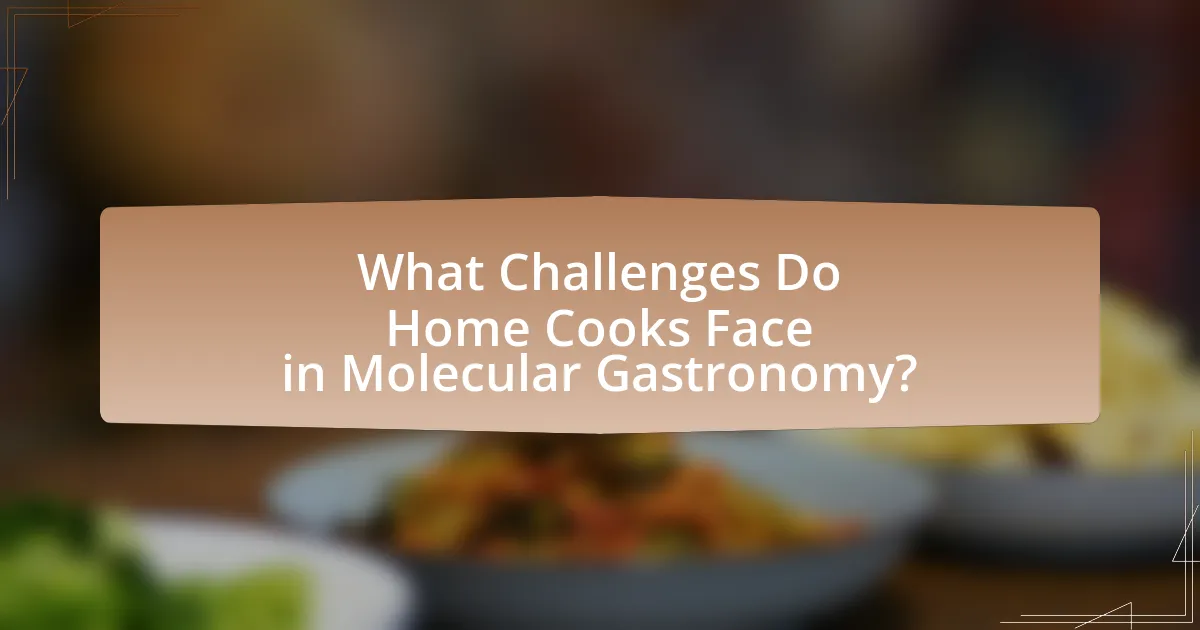
What Challenges Do Home Cooks Face in Molecular Gastronomy?
Home cooks face several challenges in molecular gastronomy, primarily due to the complexity of techniques and the need for specialized equipment. The intricate processes, such as spherification and emulsification, require precise measurements and timing, which can be difficult for those without culinary training. Additionally, the necessity for specific ingredients, like agar-agar or liquid nitrogen, can limit accessibility and increase costs. Research indicates that many home cooks struggle with the scientific principles underlying these techniques, leading to inconsistent results and frustration.
What common mistakes should home cooks avoid?
Home cooks should avoid common mistakes such as not measuring ingredients accurately, which can lead to imbalanced flavors and textures. Accurate measurements are crucial in cooking, especially in molecular gastronomy, where precise ratios can affect chemical reactions and the final dish’s outcome. Additionally, home cooks often neglect to read recipes thoroughly before starting, resulting in missed steps or ingredients. This oversight can disrupt the cooking process and lead to unsatisfactory results. Another mistake is not allowing ingredients to reach room temperature before cooking, which can affect cooking times and the final texture of the dish. Lastly, home cooks frequently underestimate the importance of proper equipment, as using the wrong tools can hinder the execution of innovative techniques essential in molecular gastronomy.
How can improper measurements affect the outcome of a dish?
Improper measurements can significantly alter the outcome of a dish by affecting its flavor, texture, and overall presentation. For instance, using too much salt can lead to an overly salty dish, while insufficient flour in a baking recipe can result in a dense or collapsed structure. In molecular gastronomy, precise measurements are crucial; for example, the exact ratio of ingredients can determine the success of emulsification or spherification techniques. Studies show that even a slight deviation in ingredient ratios can lead to inconsistent results, highlighting the importance of accuracy in culinary practices.
What are the pitfalls of using the wrong equipment?
Using the wrong equipment in molecular gastronomy can lead to inconsistent results, safety hazards, and wasted ingredients. Inconsistent results occur because specialized techniques often require precise tools; for example, using a standard blender instead of an immersion blender can result in improperly emulsified sauces. Safety hazards may arise from using equipment not designed for food preparation, such as non-food-safe plastics that can leach harmful chemicals. Additionally, wasted ingredients can happen when improper tools fail to execute techniques correctly, leading to spoiled or unusable food. These pitfalls highlight the importance of selecting appropriate equipment to achieve desired culinary outcomes in molecular gastronomy.
How can home cooks troubleshoot their Molecular Gastronomy experiments?
Home cooks can troubleshoot their Molecular Gastronomy experiments by systematically identifying and addressing common issues such as ingredient quality, temperature control, and technique execution. For instance, using high-quality ingredients like pure sodium alginate and calcium chloride is crucial, as impurities can lead to undesirable results. Additionally, maintaining precise temperatures is essential; for example, spherification requires specific temperature ranges to achieve the desired gel structure. Furthermore, reviewing techniques through reliable resources, such as “Molecular Gastronomy: Exploring the Science of Flavor” by Hervé This, can provide insights into proper methods and common pitfalls. By focusing on these areas, home cooks can effectively resolve issues in their experiments.
What tips can help improve the texture of a dish?
To improve the texture of a dish, consider incorporating techniques such as sous-vide cooking, which allows for precise temperature control, resulting in tender meats and vegetables. Additionally, using emulsifiers like lecithin can create smooth textures in sauces and dressings. Techniques like spherification can also enhance texture by creating unique, caviar-like spheres that burst in the mouth. These methods are supported by the principles of molecular gastronomy, which emphasize the science behind cooking to achieve desired textures.
How can flavor balance be achieved in Molecular Gastronomy recipes?
Flavor balance in Molecular Gastronomy recipes can be achieved by carefully manipulating the components of taste—sweetness, acidity, bitterness, saltiness, and umami. This involves using techniques such as spherification, emulsification, and foaming to enhance or contrast flavors effectively. For instance, incorporating acidic elements like citrus or vinegar can brighten a dish, while adding sweet components can round out sharp flavors. Additionally, using flavor pairing principles, which suggest that certain ingredients complement each other based on their chemical compounds, can further refine the balance. Research indicates that understanding the molecular structure of ingredients allows chefs to predict how flavors will interact, leading to more harmonious dishes.
What are the best practices for successful Molecular Gastronomy at home?
The best practices for successful Molecular Gastronomy at home include understanding the science behind the techniques, using high-quality ingredients, and investing in the right tools. Knowledge of the chemical reactions involved in cooking, such as spherification and emulsification, allows home cooks to manipulate textures and flavors effectively. High-quality ingredients enhance the final product, as they provide better taste and consistency. Essential tools, such as a sous-vide machine, siphons, and precision scales, facilitate precise measurements and temperature control, which are crucial for achieving desired results. These practices are supported by the growing popularity of Molecular Gastronomy in culinary schools and restaurants, indicating their effectiveness in creating innovative dishes.


